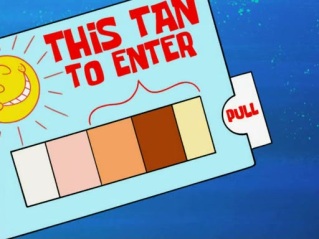“Many churches, fraternities, and nightclubs used the “brown paper bag” principle as a test for entrance. People at these organizations would take a brown paper bag and hold it against a person’s skin. If a person was lighter or the same color as the bag, he or she was admitted.”
I’ve taken this quote straight from Wikipedia, so who knows how reliable it is, but either way, this concept still exists. And the fact that it does is ridiculous. When Ifemelu first mentioned this idea, I immediately Googled it because I had suspicions about what it was and wanted to confirm them. Once my suspicions were confirmed, I immediately thought of an episode of Spongebob. I know it might sound crazy considering we’re talking about race and racism but I am going to draw some connections between this concept in Americanah and an episode of one of my favorite TV shows as a child.

This episode begins with Spongebob and Patrick being excluded from a popular party because of their lack of “tan”. The host of the party then proceeds to mock them for the lack of pigment in their skin. Obviously, right off the bat, this is a reference to racism. What’s interesting is that Spongebob and Patrick are ridiculed and excluded because of the lack of color in their skin whereas the other characters who are considered cool are much darker in color. The episode continues with Spongebob attempting to acquire a tan and then becoming even “whiter” than he had been previously, further alienating him from this “popular” society. Spongebob is considered ugly after this attempt to alter his appearance and because of that, it’s possible to draw a parallel between that and the people who attempt to “whiten” their skin in order to fit in to Western beauty standards. Society draws them in by telling them that whitening their skin will guarantee them a place in white society but when it backfires or doesn’t work as effectively as they’d hope, they’re ridiculed and distanced further from Western society’s image of “beauty”.
Spongebob continues to alter his appearance in order to achieve the color accepted in this society and at one point while he’s attempting to get into the party being held, they hold up what looks like a paint strip and compare it to Spongebob’s skin. That is a distinct reference to the paper bag test which is what originally reminded me of this episode to begin with. The entire reason I’m discussing this is because the concept of racism was introduced at such a juvenile level that it’s surprising to see the blatant connections now that I’m older and much wiser.

Does this episode of Spongebob paint a positive message? Does it teach kids that discrimination is wrong? I’m not exactly sure. But I do think it’s important that kids be exposed to such issues in order to facilitate in their understanding. But are children’s television shows the correct way to introduce kids to racism and discrimination within society?
That’s it for now.



Good job noticing such an interesting connection. It seems like children’s shows and books very frequently have messages that aren’t apparent to kids. It’s really interesting to go back and notice a deeper meaning that you missed as a child. That being said, this particular episode does a good job of sending a message without it being super overt. Even as a kid, though I didn’t realize this episode was talking about race specifically, I picked up on the meaning of exclusion being bad and of not changing yourself to fit in (which actually also connects to Ifemelu changing her hair to try to be an “acceptable” level of blackness).
LikeLike